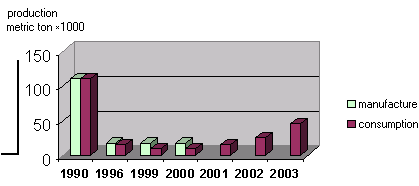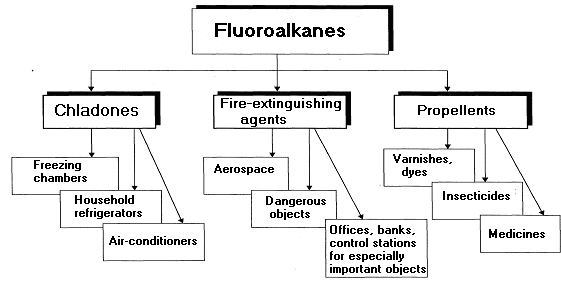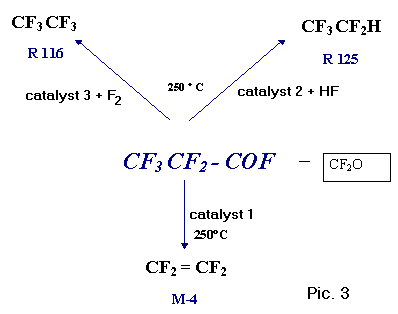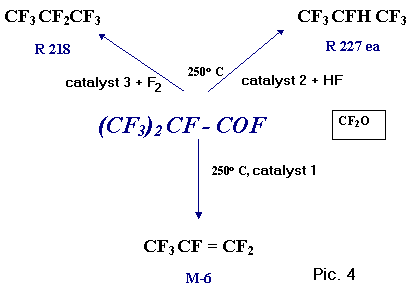Fluorine Notes, 2002, 20, 3-4
Chladone problem in Russia: ways and methods of solution
S. Igoumnov, S. Plachinda, T. Barkovskaya, V. Kornilov
Chladones (freons) are saturated fluorocarbons or polyfluorohydrocarbons ( they often contain chlorine atoms and more seldom bromine ones). Chlorine-containing chladones under UV irradiation eliminate atomic chlorine which reacts with ozone molecules.Chladones being inert, non-combustible, easy in production and storage products have been used as refrigerant liquids in industrial and household refrigerating equipment and conditioners, propellents in aerosol cylinders of different purposes, porophores (frothing agents) in manufacture of a number of building materials ( foam plastics and polyuretane foams), inert solvents, agents for dry etching in manufacture of integrated circuits, cleansers. Some chladones are used for synthesis of fluoro-monomers and different organic products. Bromine-containing chladones are used in fire-extinguishing mixtures as flame inhibitors and fire retarders for hydrocarbons.
Enactment of the Montreal protocol and manufacture of ozone-friendly
chladones abroad.
According to a theory proclaimed by American scientists in 1974 depletion
of the ozone layer takes place due to the effect of chladones, bromine-
and chlorine containing substances (chlorofluorocarbons) or freons (
according to the trade marks of the largest manufacturer of such
substances, namely DuPont company)
In March of 1985 the Vienna convention devoted to protection of the ozone
layer was accepted and in September , 1987 the Montreal protocol was
signed to implement complete layoff by developed countries of ozone-active
chladones (R11,R12,R113,R114,R115) by January1,1996 and for
bromine-containing chladones was fixed a data as January1,1994.
Low developed countries have been given a 10-year delay.
At present 175 countries, i.e. almost all the countries of the world
community, have been the parties of the Montreal protocol and Vienna
convention.
In this connection all over the world a process of development of new
environmentally safe chladones possessing necessary maintenance properties
and depleting in atmosphere with formation of inert substances has begun.
Such foreign majors as DuPont, Great Lakes, ICI etc. began a search of
alternative ozone friendly substances and development of technologies of
their production. The next stage was creation of pilot production of these
substances and then organization of large-scale capacities for their
production.
Du Pont finished conversion to ozone safe substances already in 1988 and
became a leader at the chladone market.
By 1999 the total volume of ozone safe chladones produced in the USA was
21.1 mln metric ton relatively the carbon-equivavalent (IPCC data, Special
report on emission scenarious, Fenhann/2000)
Manufacture and consumption of chladones in Russia, fulfilment of international obligations on protection of the ozone layer by Russia.
Russia has inherited participation in the obligations from the former
USSR. Starting since 1992 the Government of Russia issued several decrees
with the purpose to provide fulfillment by Russia of the obligations but
they have not been fulfilled.
By the moment of signing the Montreal protocol our country was among the
largest world producers and consumers of ODS (ozone depleting substances).
The peak of their manufacture fell on 1990 (197490 tons including 110140
tons of chladones) and accounted 20% of the world level. In 1996 a
reduction of the total output of ODS production followed to 47575 tons
including 17122 tons of chladones.

Pic.1 Manufacture and consumption of chladones in Russia.
Only in late 2000year the sequence of delays was finished and manufacture
of ODS has been stopped in Russia since December 20, 2000.
The largest plants in Perm-city, Volgograd and other regions manufactured
ODS stopped their production.
At the same time beginning from 2001 a stable growth in main branches of industry
consuming chladones has been observed. That makes possible to
forecast an increase in consumption of ozone-safe chladones in the near
future that is shown in Pic.1.
To summarise the above mentioned it should be noted that manufacture of
ODS in Russia has been stopped whereas domestic production of ozone safety
chladones has been in embryo. The increase in consumption in our case,
unfortunately, does not mean an increase in their manufacture to meet
growing demand. The constantly growing demand results in a critical
shortage of these products that is confirmed by a sharp increase of their
cost comparing with 1996-97yy.
Market demand saturation may occur either using own resources or at the
expense of foreign manufacturers.
Let us analyse a possibility of consumption by enterprises-consumers of
chladone stocks produced and collected by domestic producers before
December 2000.
Beginning from 1996 the manufacture of ODS in Russia was strictly limiting
and the amounts produced according to these limits (quotas) were hardly
sufficient to provide normal functioning of enterpises-consumers.
Table 1 containing the quotas for manufacture of chladones for the largest
Russian plants in 1997 is given below as an example. The total quota for
1997 is 19,000.00 tons that accounts approximately 1/6 of the production
output in 1990. In 1997 this quota at a reduced chladone consumption could
meet chladone demand. Such a situation remained till the late 2000.
Table 1 Quotas for chladone manufacture in1997 for Russian enterprises for
substances related to group 1 of Appendix A to the Montreal protocol
| Substance | Enterprise | Quota, tons | Quota*, ODP tons |
| Chladone-11 | JSC HALOGEN ,Perm-city | 7000 | 7000 |
| Chladone-12 | JSC KAUSTIK , Volgograd | 4000 | 4000 |
| JSC CHIMPROM, Volgograd | 5000 | 5000 | |
| JSC ALtAICHIMPROM, t.Jarovoe | 1000 | 1000 | |
| Chladone 113 | JSC CHIMPROM, Volgograd | 1000 | 800 |
| JSC Kirovo-Chepetsky Chimichesky Kombinat, t. Kirovo-Chepetsk | 1000 | 800 | |
| Total quota in 1997 | 19000 | 18600 | |
| Total production output in1990 | 110140 | 105300 |
In their turn, enterprises-consumers of chladones related to different
industry branches got their quotas for consumption.
Table2. Schedule of planning stepwise phase –out of chladones
(admissible amount in tons)
|
Consumption area |
1998 | 1999 | 2000 |
| Aerosols | 3300 | 1800 | 0 |
| Refrigerants | 4500 | 2800 | 0 |
| Foam materials | 520 | 300 | 0 |
| Solvents | 500 | 200 | 0 |
| Total | 8820 | 5100 | 0 |
Total consumption of ozone depleting chladones by 1998 accounted 8820 tons, 5100 tons by 1999 and it should be stopped completely by 2000y.
Conversion to the use of ozone-safe chladones had to be carried out at the same time with the forced reduction in consumption of ozone-depleting chladones with the purpose to provide full-time functioning of enterprises-consumers of this materials. In 2000y the situation completely changed. Manufacture of ozone-depleting chladones has been stopped at all. There is no exact evaluation of the remained amount. Based on the data of their production output and consumption before 2000y one may assume that this stock is not large, its use is strictly regulated and limited.
An additional reserve for branches consuming chladones, first of all for areas of cooling equipment and fire-extinguishing , is systems of regeneration chladones and halons collected from equipment out of use. That makes possible to meet partly demands of enterprises-consumers of chladones. But regeneration is a temporary and expensive solution of the problem that makes it reasonable only at the places of consumption.
Necessity to phase-out refrigerants, propellents, frothing agents and fire-extinguishers , which are chladones, within the periods set by the Montreal protocol resulted in intensive search for acceptable alternatives.
Hydrocarbon propellents of propane or butane type have been widely used in aerosol application . About 80% of aerosols produced in Europe are based on using exactly such substances. A part of domestic manufacturers (JSC “Arnest”, Nevinnomysk city, Stavropolsky region, JSC “Chimprom”, JSC “Sibiar', JSC “Harmonia”, JSC “ Mariholodmash”) using European technologies and the grants of the Global Environmental Fund have replaced chladones 11 and 12 with hydrocarbon propellents.
It may be assumed that thus the enterprises provided a short-term perspective for them due to the following reasons. First, that is total dependence on the West in the further financing of new equipment purchase and control over distribution of the earnmarkings from the Western side. The second reason in our opinion is of vital importance , namely the technology for using natural gases as propellents in aerosol packings had been accepted mainly by European consortiums. The recognition of propane-butane mixtures as an ideal propellent and of their wholesome influence on human organism, in aerosols for medical purposes in particular, is rather disputable. Not in vain the main world manufacturers of chladones such as Great lakes, ICI (at the moment INEOS Fluo), DuPont and Solvey counted on chladone 227ea which on the base of studies had been recognized as the main aerosol propellent both for medicines and for aerosols of industrial purposes.
The same or similar situation is observed in other areas of ODS consumption.
All the above mentioned may be summarised as follows.
The signing by Russia of the obligations of the Montreal protocol and Vienna convention has brought to directive layoff of ozone depleting chladones. The market of chladone consumption is developing spontaneously within the existing tendencies. In this connection a part of emterprises-manufacturers using assignments of GEF have started manufacture of substitutes and transition chladones catered for European producers. The rest enterprises are trying by own strength to implement manufacture of some product at small pilot plants oriented for a possible market without exact coordination. Thus, unsystematic fragmental organization of production takes place on the basis of outdated technologies under conditions of critical shortage of ozone-safe chladones. The enterprises-consumers are forced either to use the residual stocks of ozone-depleting chladones according to the fixed quotas or to resort to arrangement of regeneration systems, or to buy the necessary products abroad.
The solution of the critical shortage problem may be developed in two ways, first of them is creation of a target federal program on organization of production of ozone-safe chladones at the territory of the Russia Federation on a state scale. The problem should include paragraphs coordinating creation of production systems instead of those stopped in 2000y. Certification and compliance tables of new chladones in comparison with old ones also are necessary.
The absence of the target program will lead at last to total loss of domestic and foreign markets that will negatively influence the process of stabilization of industrial manufacture and the economic security of the country with regard to provision of the Russian market with the ozone-safe chladones. Such a situation has occurred in Ukraine where the market is completely occupied by foreign manufacturers of chladones.
One of aspects of economic security of our country is closely bound up with the matter of import of chladones. In the absence of domestic manufacture of ozone-safe chladones Russia will be forced to buy them permanently abroad to provide full-scale functioning of dangerous objects (nuclear-powered submarines, atomic power stations, rocket airfields etc.).
For example the USA in 1999 got a quota for manufacture of prohibited ODS for development a program for “Shuttle” in amount of 1085.3 tons, i.e. even more than it was produced in Russia in 1998y according to the Federal program. To provide launching domestic carrier rockets of civil and military purposes it is required at least the same amount of chladones. Russia has not got quotas for their production so it is easy to evaluate the importance of the organization of domestic production of ozone-safe chladones for protection of national interests of our country.
Important technological solution of the problem of production of fluoroorganic products.
Production of these materials is based on treatment of basic fluoroorganic
products.
We consider basic fluoroorganic compounds as fluorine-containing alkanes (chladones
are among them) and fluoromonomers.
The areas of application of fluoroalkanes are presented in Pic.2

At present fluoroalkanes are subdivided into two classes, i.e. the ozone
depleting fluoroalkanes containing chlorine and bromine in the molecule
and the ozone-safe ones without these atoms.
Up to now all over the world there has been used actually the same
technology for manufacture of the said products. The technology includes
chlorination of hydrocarbon raw followed by its fluorination with hydrogen
fluoride over catalyst. In such a way chladone 22 is produced which is
then used for manufacture of tetrafluoroethylene by pyrolysis.
The equation below shows that even theoretical output of monomer requires
4 tons of chlorine per 1 ton of monomer and also 3.5 tons of hydrogen
chloride should be utilized. A similar scheme is used for manufacture of
ozone-safe chladone 125.
![]()
But the most unpleasant thing is not even consumption of chlorine and
formation of hydrogen chloride. Production of fluorine-containing products
according to this technology requires manufacture of chlorinated raw
materials. But now it has been reliably proved that any production of any
chloroorganic products produces dioxines. But we have no way to deal with
dioxines: either they will have driven out us from the planet or we will
have stopped their production.
Hence, manufacturers accepting technologies based on treatment of
chlorinated raw materials run risks in the nearest future to be placed
under prohibition sanctions of a regular international convention
excluding production of chloroorganic products.
But in foreseeable future the humanity not only will be able to refuse
production of chloroorganic substances but most probably will increase
their production.
In this connection the necessity of development and implementation of new
technologies without using chlorine for manufacture of these products is
obvious.
Our company have been studied development of such technologies for several
years to avoid the use of chlorine-containing raw materials.
We assume to use products of a large-scale production of polymer industry
as a feedstock . Further fluorine is introduced in these products by
electrochemical fluorination.
From the compounds produced in such a way we obtain the same fluoroorganic
compounds which are the basis of all production of fluorine-containing
materials.


We believe that in result a principally new environmentally safe, economically competitive way for production of basic fluoroorganic products has been found. Within the frames of this idea implementation collaborators of the scientific center of our company developed a production method and patented a technology which made possible to obtain in one production line four ozone-safe chladones and 2 semi-products:M-4 and M-6 (Pic.3 and Pic.4). At the territory of the Perm branch of RSC “Applied Chemistry” we launched pilot plants for the above mentioned products. The operation of the plants confirmed both economic effectiveness ( a ratio of price/quality) and reliability of the operation and environmentally safety of the method proposed.
Fluorine Notes, 2002, 20, 3-4
